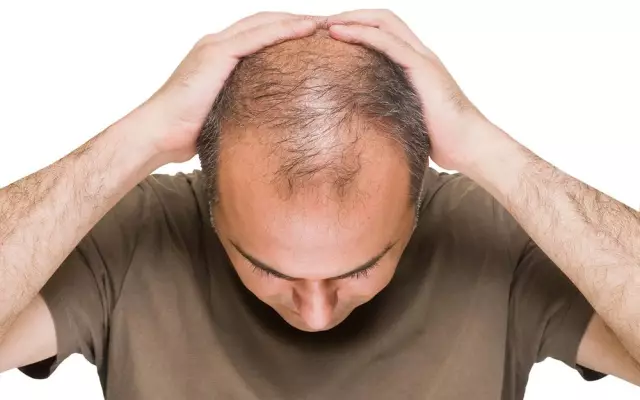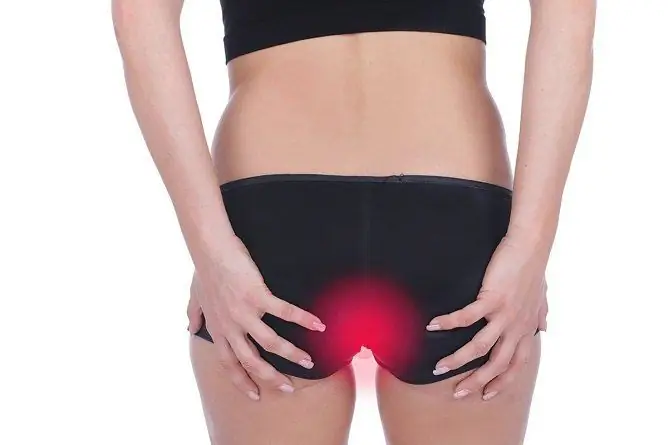- Author Rachel Wainwright [email protected].
- Public 2023-12-15 07:39.
- Last modified 2025-11-02 20:14.
Hyperandrogenism
The content of the article:
- Causes
- Kinds
- Symptoms of hyperandrogenism
- Features of the course of hyperandrogenism in children
- Diagnostics
- Treatment of hyperandrogenism
- Prevention
- Consequences and complications
Hyperandrogenism is a general designation of a number of endocrine pathologies of various etiologies, characterized by excessive production of male hormones - androgens in the woman's body or increased susceptibility to steroids from the target tissues. Most often, hyperandrogenism in women is first diagnosed at reproductive age - from 25 to 45 years; less often in adolescent girls.

Source: klinika-bioss.ru
Causes
Hyperandrogenism is a manifestation of a wide range of syndromes. Experts name the three most likely causes of hyperandrogenism:
- increased serum androgen levels;
- conversion of androgens into metabolically active forms;
- active utilization of androgens in target tissues due to abnormal sensitivity of androgen receptors.
Excessive synthesis of male sex hormones is usually associated with impaired ovarian function. The most common is polycystic ovary syndrome (PCOS) - the formation of multiple small cysts against the background of a complex of endocrine disorders, including pathologies of the thyroid and pancreas, pituitary gland, hypothalamus and adrenal glands. The incidence of PCOS among women of fertile age reaches 5-10%.
Androgen hypersecretion is also observed with the following endocrinopathies:
- adrenogenital syndrome;
- congenital adrenal hyperplasia;
- galactorrhea-amenorrhea syndrome;
- stromal tekomatosis and hyperthecosis;
- virilizing tumors of the ovaries and adrenal glands, producing male hormones.
Hyperandrogenism due to the transformation of sex steroids into metabolically active forms is often caused by various disorders of lipid-carbohydrate metabolism, accompanied by insulin resistance and obesity. Most often, there is a transformation of testosterone produced by the ovaries into dihydrotestosterone (DHT), a steroid hormone that stimulates the production of sebum and the growth of stem hair on the body, and in rare cases, loss of scalp hair.
Compensatory overproduction of insulin stimulates the production of androgen-producing ovarian cells. Transport hyperandrogenism is observed with a lack of globulin that binds the free fraction of testosterone, which is characteristic of Itsenko-Cushing's syndrome, dyslipoproteinemia and hypothyroidism. With a high density of androgen receptors in ovarian tissue cells, skin, hair follicles, sebaceous and sweat glands, symptoms of hyperandrogenism can be observed with a normal level of sex steroids in the blood.
The probability of manifestation of pathological conditions associated with the symptom complex of hyperandrogenism depends on a number of factors:
- hereditary and constitutional predisposition;
- chronic inflammatory diseases of the ovaries and appendages;
- miscarriages and abortions, especially in early youth;
- metabolic disorders;
- overweight;
- bad habits - smoking, alcohol and drug abuse;
- distress;
- long-term use of drugs containing steroid hormones.
Idiopathic hyperandrogenism is congenital or occurs during childhood or puberty for no apparent reason.
Kinds
In gynecological practice, several types of hyperandrogenic conditions are distinguished, which differ from each other in etiology, course and symptomatology. Endocrine pathology can be either congenital or acquired. Primary hyperandrogenism, not associated with other diseases and functional disorders, is caused by disorders of the pituitary regulation; secondary is the result of concomitant pathologies.
Based on the specifics of manifestation, there are absolute and relative varieties of hyperandrogenism. The absolute form is characterized by an increase in the level of male hormones in the blood serum of a woman and, depending on the source of androgen hypersecretion, are divided into three categories:
- ovarian, or ovarian;
- adrenal, or adrenal;
- mixed - signs of ovarian and adrenal forms are present at the same time.
Relative hyperandrogenism occurs against the background of a normal content of male hormones with an excessive sensitivity of target tissues to sex steroids or enhanced transformation of the latter into metabolically active forms. Iatrogenic hyperandrogenic states that develop as a result of prolonged use of hormonal drugs are distinguished into a separate category.
Symptoms of hyperandrogenism
The clinical picture of hyperandrogenic states is characterized by a wide variety of manifestations that fit into the standard complex of symptoms:
- disorders of menstrual function;
- metabolic disorders;
- androgenic dermopathy;
- infertility and miscarriage.
The severity of symptoms depends on the cause and form of endocrinopathy, concomitant diseases and individual characteristics. For example, dysmenorrhea manifests itself especially clearly with ovarian hyperandrogenism, which is accompanied by anomalies in the development of follicles, hyperplasia and uneven detachment of the endometrium, cystic changes in the ovaries. Patients complain of scanty and painful menstruation, irregular or anovulatory cycles, uterine bleeding, and premenstrual syndrome. With galactorrhea-amenorrhea syndrome, progesterone deficiency is noted.
Severe metabolic disorders - dyslipoproteinemia, insulin resistance and hypothyroidism are characteristic of the primary pituitary and adrenal forms of hyperandrogenism. In about 40% of cases, patients have abdominal obesity of the male type or with a uniform distribution of adipose tissue. In adrenogenital syndrome, an intermediate structure of the genitals is observed, and in the most severe cases, pseudohermaphroditism. Secondary sexual characteristics are poorly expressed: in adult women, there is underdevelopment of the breast, a decrease in the timbre of the voice, an increase in muscle mass and body hair; later menarche is typical for girls. The rapid development of signs of virilization in an adult woman gives reason to suspect an androgen-producing tumor of the ovary or adrenal gland.
Androgenic dermopathy is usually associated with increased activity of dihydrotestosterone. The effect of a hormone that stimulates the secretory activity of the skin glands changes the physicochemical properties of sebum, provoking a blockage of the excretory ducts and inflammation of the sebaceous glands. As a result, 70-85% of patients with hyperandrogenism show signs of acne - acne, enlarged skin pores and comedones.
Less common are other manifestations of androgenic dermatopathy - seborrhea and hirsutism. Unlike hypertrichosis, in which there is excess hair growth throughout the body, hirsutism is characterized by the transformation of vellus hair into hard terminal hair in androgen-sensitive areas - above the upper lip, on the neck and chin, on the back and chest around the nipple, on the forearms, legs and inner side of the thigh. In postmenopausal women, bitemporal and parietal alopecia are occasionally noted - hair loss on the temples and in the crown of the head, respectively.

Source: woman-mag.ru
Features of the course of hyperandrogenism in children
In the pre-pubertal period, girls may develop congenital forms of hyperandrogenism due to genetic abnormalities or exposure to androgens on the fetus during pregnancy. Pituitary hyperandrogenism and congenital adrenal hyperplasia are recognized by the girl's pronounced virilization and abnormalities in the structure of the genitals. In adrenogenital syndrome, signs of false hermaphroditism may be present: clitoral hypertrophy, fusion of the labia majora and vaginal opening, displacement of the urethra to the clitoris and urethrogenital sinus. Simultaneously noted:
- early overgrowth of fontanelles and epiphyseal fissures in infancy;
- premature body hair;
- rapid somatic growth;
- delayed puberty;
- late menarche or absence of menstruation.
Congenital adrenal hyperplasia is accompanied by impaired water-salt balance, skin hyperpigmentation, hypotension and autonomic disorders. Starting from the second week of life, with congenital adrenal hyperplasia and severe adrenogenital syndrome, it is possible to develop an adrenal crisis - acute adrenal insufficiency, associated with a threat to life. Parents should be alerted to a sharp drop in blood pressure to a critical level, vomiting, diarrhea and tachycardia in a child. In adolescence, an adrenal crisis can provoke nervous shocks.
Moderate hyperandrogenism in adolescence, associated with a sharp growth spurt, should be differentiated from congenital polycystic ovary disease. The onset of PCOS often occurs at the stage of the formation of menstrual function.
Diagnostics
It is possible to suspect hyperandrogenism in a woman by characteristic changes in appearance and based on anamnesis data. To confirm the diagnosis, determine the shape and identify the cause of the hyperandrogenic state, a blood test for androgens is performed - total, free and biologically available testosterone, dihydrotestosterone, dehydroepiandrosterone sulfate (DEA sulfate), as well as sex hormone binding globulin (SHBG).
Normally, the content of free testosterone in the blood serum of sexually mature women under 50 ranges from 0.001 to 0.0034 nmol / liter, biologically available testosterone - from 0.033 to 0.774 nmol / liter. For older women, the indicators are 0.001-0.022 and 0.002-0.46 nmol / liter, respectively. An increased testosterone content indicates an ovarian origin of hyperandrogenism; an increase in the concentration of DEA sulfate - about hyperandrogenism of the adrenal genesis. Extremely high levels of testosterone and DEA sulfate may indicate a virilizing tumor.
In order to identify the pathology of the ovaries that caused ovarian hyperandrogenism, ultrasound of the pelvic organs and additional laboratory studies of the hormonal background with the determination of the level of estradiol, prolactin, luteinizing and follicle-stimulating hormones are prescribed.
In hyperandrogenic states of adrenal, pituitary and transport etiology, a woman is referred for MRI or CT of the pituitary gland and adrenal glands. According to indications, blood tests for 17-hydroxyprogesterone and urine tests for cortisol and 17-ketosteroids are performed. Laboratory tests are used to diagnose metabolic pathologies:
- tests with dexamethasone and human chorionic gonadotropin;
- determination of cholesterol and lipoprotein levels;
- blood sugar and glycated glycogen tests, glucose tolerance test;
- tests with adrenocorticotropic hormone.
To improve the visualization of glandular tissue, if a neoplasm is suspected, MRI or CT with the use of contrast agents is indicated.
Treatment of hyperandrogenism
Correction of hyperandrogenism gives a lasting result only in the treatment of major diseases, such as PCOS or Itsenko-Cushing's syndrome, and concomitant pathologies - hypothyroidism, insulin resistance, hyperprolactinemia, etc.
Hyperandrogenic states of ovarian genesis are corrected with the help of estrogen-progestogenic oral contraceptives, which suppress the secretion of ovarian hormones and block androgen receptors. With severe androgenic dermopathy, peripheral blockade of skin receptors, sebaceous glands and hair follicles is performed.
In the case of adrenal hyperandrogenism, corticosteroids are used; with the development of metabolic syndrome, insulin synthetizers are additionally prescribed in combination with a low-calorie diet and dosed physical activity. Androgen-secreting neoplasms are usually benign and do not recur after surgical removal.
For women planning pregnancy, treatment of hyperandrogenism is a prerequisite for the restoration of reproductive function.
Prevention
To prevent hyperandrogenic conditions, women and adolescent girls are recommended preventive examinations by a gynecologist and screening tests to control androgenic status. Early detection and treatment of gynecological diseases, timely correction of hormonal levels and competent selection of contraceptives successfully prevent hyperandrogenism and contribute to the maintenance of reproductive function.
With a tendency to hyperandrogenism and congenital adrenopathies, it is important to adhere to a healthy lifestyle and a sparing regime of work and rest, give up bad habits, limit the influence of stress, lead an orderly sex life, avoid abortion and emergency contraception; uncontrolled intake of hormonal drugs and anabolic drugs is strictly prohibited. Control of body weight is also important; moderate physical activity without heavy physical activity is preferable.
Consequences and complications
Hyperandrogenic conditions are one of the most common causes of female infertility and miscarriage. A prolonged course of hyperandrogenism increases the risk of developing metabolic syndrome and type II diabetes mellitus, atherosclerosis, arterial hypertension and coronary heart disease. According to some reports, high androgen activity correlates with the incidence of some forms of breast cancer and cervical cancer in women infected with oncogenic papillomaviruses. In addition, aesthetic discomfort in androgenic dermopathy has a strong psychotraumatic effect on patients.
Congenital hyperandrogenism of the adrenal genesis in children and adolescent girls can suddenly be complicated by an adrenal crisis. Due to the possibility of a fatal outcome at the first signs of acute adrenal insufficiency, the child should be immediately taken to the hospital.
YouTube video related to the article:

Anna Kozlova Medical journalist About the author
Education: Rostov State Medical University, specialty "General Medicine".
The information is generalized and provided for informational purposes only. At the first sign of illness, see your doctor. Self-medication is hazardous to health!






